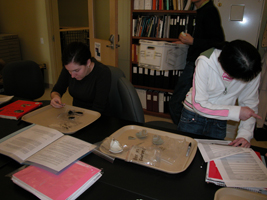Hello, my name is Rachel, and I am a graduate student in the Department of Cultural and Social Anthropology. I decided to take CASA 203 Lab Methods class, as coming from a different disciplinary background, the class offers the learning of skills I need to acquire! Although my research is in Ghana, West Africa, I view these techniques and methods as highly transferable. I have thoroughly enjoyed working with these artifacts – the tangible nature of these objects brings history alive. I am very grateful to the Chinese Historical and Cultural Project and the community for allowing me to participate in this fascinating project. Thank you.
This week we turned from glass analysis to metals. Metals are interesting since depending on their composition they change in appearance with time: copper and copper alloys develop a green patina, silver and pewter turns black or dark grey, iron and iron alloys develop a red corrosion, and white metals (lead, tin, aluminum and zinc) develop a white or grey patina. We didn’t examine gold, but this does not corrode. Some of the objects we examined were: jewelry, bolts, nails (and more nails!), a pencil top, buttons, a suspender holder and what I thought looked like a door handle! On Friday, we worked on our own individual research projects in which we analyze objects from the collection. To that end, I went with Bryn to the storage to look for something to research. Wow! So many boxes! I was thrilled to find – in the first box I examined – a watch and some pieces of broken dolls. I also discovered a minature doll, that Professor Voss tells me is called a ‘Frozen Charlotte’. Well, it was a tough decision between the watch and the dolls, but the latter won! I am really looking forward to learning more about children and childhood in Market Street Chinatown.
Featured Artifact
The artifact of the week is my unexpected discovery – a Prosser button. I thought this was rather exciting since it was inside the base fragment of a green bottle probably used to hold alcohol. The button was not catalogued which meant that we had to create a record for it. White in color, with a glassy appearance, in actuality, it was only half of a button, yet one can see a distinct design around the edges. Made of high fired clays, these buttons were manufactured in several styles between 1850 and 1920. Although small in size, buttons are interesting and can tell us a lot about the past; they are good indicators of gender, economic status and activities of a site’s occupants.


